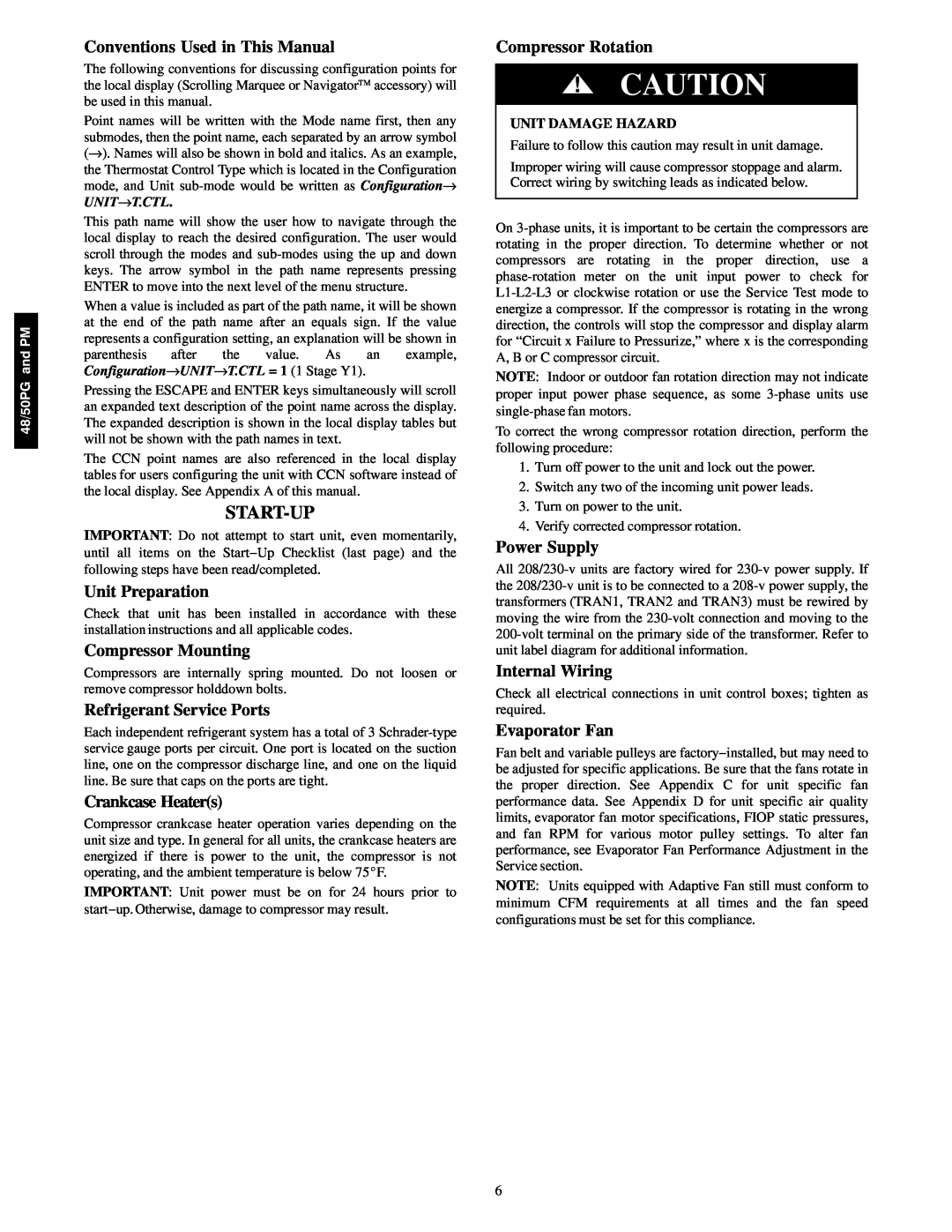
48/50PG and PM
Conventions Used in This Manual
The following conventions for discussing configuration points for the local display (Scrolling Marquee or Navigator accessory) will be used in this manual.
Point names will be written with the Mode name first, then any submodes, then the point name, each separated by an arrow symbol (→). Names will also be shown in bold and italics. As an example, the Thermostat Control Type which is located in the Configuration mode, and Unit
This path name will show the user how to navigate through the local display to reach the desired configuration. The user would scroll through the modes and
When a value is included as part of the path name, it will be shown at the end of the path name after an equals sign. If the value represents a configuration setting, an explanation will be shown in
parenthesis after the value. As an example, Configuration→UNIT→T.CTL = 1 (1 Stage Y1).
Pressing the ESCAPE and ENTER keys simultaneously will scroll an expanded text description of the point name across the display. The expanded description is shown in the local display tables but will not be shown with the path names in text.
The CCN point names are also referenced in the local display tables for users configuring the unit with CCN software instead of the local display. See Appendix A of this manual.
START-UP
IMPORTANT: Do not attempt to start unit, even momentarily, until all items on the Start−Up Checklist (last page) and the following steps have been read/completed.
Unit Preparation
Check that unit has been installed in accordance with these installation instructions and all applicable codes.
Compressor Mounting
Compressors are internally spring mounted. Do not loosen or remove compressor holddown bolts.
Refrigerant Service Ports
Each independent refrigerant system has a total of 3
Crankcase Heater(s)
Compressor crankcase heater operation varies depending on the unit size and type. In general for all units, the crankcase heaters are energized if there is power to the unit, the compressor is not operating, and the ambient temperature is below 75_F.
IMPORTANT: Unit power must be on for 24 hours prior to start−up. Otherwise, damage to compressor may result.
Compressor Rotation
!CAUTION
UNIT DAMAGE HAZARD
Failure to follow this caution may result in unit damage.
Improper wiring will cause compressor stoppage and alarm. Correct wiring by switching leads as indicated below.
On
NOTE: Indoor or outdoor fan rotation direction may not indicate proper input power phase sequence, as some
To correct the wrong compressor rotation direction, perform the following procedure:
1.Turn off power to the unit and lock out the power.
2.Switch any two of the incoming unit power leads.
3.Turn on power to the unit.
4.Verify corrected compressor rotation.
Power Supply
All
Internal Wiring
Check all electrical connections in unit control boxes; tighten as required.
Evaporator Fan
Fan belt and variable pulleys are factory−installed, but may need to be adjusted for specific applications. Be sure that the fans rotate in the proper direction. See Appendix C for unit specific fan performance data. See Appendix D for unit specific air quality limits, evaporator fan motor specifications, FIOP static pressures, and fan RPM for various motor pulley settings. To alter fan performance, see Evaporator Fan Performance Adjustment in the Service section.
NOTE: Units equipped with Adaptive Fan still must conform to minimum CFM requirements at all times and the fan speed configurations must be set for this compliance.
6
